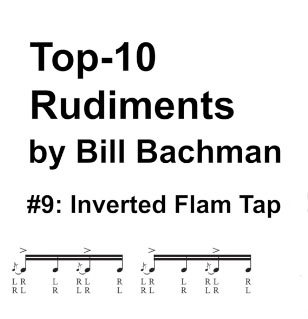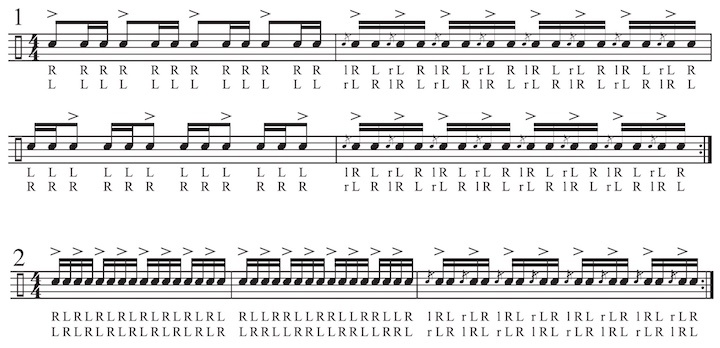Top-10 Rudiments, Part 9: Inverted Flam Tap


Some may assume that the inverted flam tap is similar to the standard flam tap, which we covered in the previous chapter, but the inverted flam tap actually sounds quite different— and playing it requires a totally different technique.
The inverted flam tap looks like the standard flam tap until you notice the unique sticking. Unlike the standard flam tap where the tap follows an accent with the same hand, the tap now precedes the accent with the same hand. This is what makes the rudiment tricky. The challenge is to quickly get to the accent after the tap without a rhythmic delay or tension as you lift up the stick. Using the Moeller whip stroke makes it much easier to achieve the proper stick height for the accent. The goal in learning this rudiment is to have well-trained hands that can effortlessly play patterns such as shuffle grooves, where taps immediately precede accents.
To review, a Moeller whip downstroke is a modified downstroke that’s played from the forearm with a whipping motion rather than from the wrist. As a general rule, the Moeller whip stroke should be implemented when you need to quickly get the stick up for accents at speeds where the wrist would otherwise struggle to do so. Simply put, the Moeller stroke allows you to smoothly play accent patterns from your forearm with a relaxed hand, instead of overworking your wrist. Advertisement
Let’s first look at the technique necessary to play inverted flam taps at a slow speed. Each hand plays two low taps (the first of which is a grace note) followed by a high accent stroke. At this tempo you can easily play a low tap stroke, an upstroke, and a downstroke using the wrists. If you try to play inverted flam taps at a medium or fast speed with the same technique, your wrists will tighten up, since there’s not enough time for the hands to play an upstroke preceding the accented flam. Again, this is where the Moeller stroke comes in and replaces the wrist motion with a forearm motion.
The tap immediately preceding the accented flam will be played with a Moeller upstroke, where the stick just happens to hit the drum as you pick up the forearm and let the wrist hang limp. Regardless of the tempo, be sure to quickly stifle the stick’s rebound after the accent in order to freeze the stick pointing down toward the drum (Moeller whip downstroke). This will help you maintain a good stick-height differential between the accents and taps in order to achieve maximum musical contrast. Also be sure to coordinate the two hands so that the flams are consistent from hand to hand; if one hand’s flam is wider than the other’s, then that hand needs to better develop the quick Moeller whip stroke.

This article is culled from Bill Bachman’s popular Stick Technique book, which is designed to help players develop hands that are loose, stress free, and ready to play anything that comes to mind. The book is for everyone who plays with sticks, regardless of whether you’re focusing primarily on drumset, orchestral percussion, or the rudimental style of drumming. Divided into three main sections – Technique, Top-Ten Rudiments, and Chops Builders – Stick Technique is designed to get you playing essential techniques correctly and as quickly as possible. Also includes a bonus section two-hand coordination and independence. Advertisement

